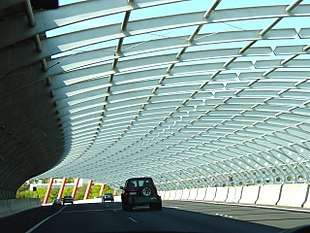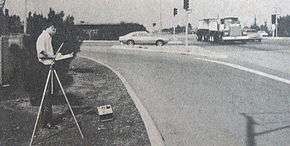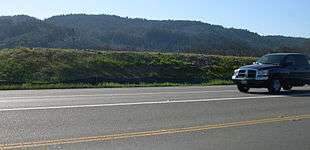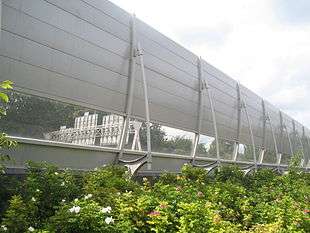Noise barrier
A noise barrier (also called a soundwall, noise wall, sound berm, sound barrier, or acoustical barrier) is an exterior structure designed to protect inhabitants of sensitive land use areas from noise pollution. Noise barriers are the most effective method of mitigating roadway, railway, and industrial noise sources – other than cessation of the source activity or use of source controls.

In the case of surface transportation noise, other methods of reducing the source noise intensity include encouraging the use of hybrid and electric vehicles, improving automobile aerodynamics and tire design, and choosing low-noise paving material. Extensive use of noise barriers began in the United States after noise regulations were introduced in the early 1970s.
History
Noise barriers have been built in the United States since the mid-twentieth century, when vehicular traffic burgeoned. I-680 in Milpitas, California was the first noise barrier.[1] In the late 1960s, analytic acoustical technology emerged to mathematically evaluate the efficacy of a noise barrier design adjacent to a specific roadway. By the 1990s, noise barriers that included use of transparent materials were being designed in Denmark and other western European countries.[2] Below, a researcher collects data to calibrate a roadway noise model for Foothill Expressway.

The best of these early computer models considered the effects of roadway geometry, topography, vehicle volumes, vehicle speeds, truck mix, road surface type, and micro-meteorology. Several U.S. research groups developed variations of the computer modeling techniques: Caltrans Headquarters in Sacramento, California; the ESL Inc. group in Sunnyvale, California; the Bolt, Beranek and Newman[3] group in Cambridge, Massachusetts, and a research team at the University of Florida. Possibly the earliest published work that scientifically designed a specific noise barrier was the study for the Foothill Expressway in Los Altos, California.[4]
Numerous case studies across the U.S. soon addressed dozens of different existing and planned highways. Most were commissioned by state highway departments and conducted by one of the four research groups mentioned above. The U.S. National Environmental Policy Act[5] effectively mandated the quantitative analysis of noise pollution from every Federal-Aid Highway Act Project in the country, propelling noise barrier model development and application. With passage of the Noise Control Act of 1972,[6] demand for noise barrier design soared from a host of noise regulation spinoff.
By the late 1970s, more than a dozen research groups in the U.S. were applying similar computer modeling technology and addressing at least 200 different locations for noise barriers each year. As of 2006, this technology is considered a standard in the evaluation of noise pollution from highways. The nature and accuracy of the computer models used is nearly identical to the original 1970s versions of the technology.
Design
The acoustical science of noise barrier design is based upon treating an airway or railway as a line source. The theory is based upon blockage of sound ray travel toward a particular receptor; however, diffraction of sound must be addressed. Sound waves bend (downward) when they pass an edge, such as the apex of a noise barrier. Barriers that block line of sight of a highway or other source will therefore block more sound.[7] Further complicating matters is the phenomenon of refraction, the bending of sound rays in the presence of an inhomogeneous atmosphere. Wind shear and thermocline produce such inhomogeneities. The sound sources modeled must include engine noise, tire noise, and aerodynamic noise, all of which vary by vehicle type and speed.
The noise barrier may be constructed on private land, on a public right-of-way, or on other public land. Because sound levels are measured using a logarithmic scale, a reduction of nine decibels is equivalent to elimination of approximately 86 percent of the unwanted sound power.

Materials
Several different materials may be used for sound barriers. These materials can include masonry, earthwork (such as earth berm), steel, concrete, wood, plastics, insulating wool, or composites.[8] Walls that are made of absorptive material mitigate sound differently than hard surfaces.[9] It is now also possible to make noise barriers with active materials such as solar photovoltaic panels to generate electricity while also reducing traffic noise. [10] [11][12]
A wall with porous surface material and sound-dampening content material can be absorptive where little or no noise is reflected back towards the source or elsewhere. Hard surfaces such as masonry or concrete are considered to be reflective where most of the noise is reflected back towards the noise source and beyond.[13]
Noise barriers can be effective tools for noise pollution abatement, but certain locations and topographies are not suitable for use of noise barriers. Cost and aesthetics also play a role in the choice of noise barriers. In some cases, a roadway is surrounded by a noise abatement structure or dug into a tunnel using the cut-and-cover method.
Tradeoffs

Potential disadvantages of noise barriers include:
- Aesthetic impacts for motorists and neighbors, particularly if scenic vistas are blocked[14]
- Costs of design, construction, and maintenance
- Necessity to design custom drainage that the barrier may interrupt
Normally, the benefits of noise reduction far outweigh aesthetic impacts for residents protected from unwanted sound. These benefits include lessened sleep disturbance, improved ability to enjoy outdoor life, reduced speech interference, stress reduction, reduced risk of hearing impairment, and a reduction in the elevated blood pressure created by noise (that improves cardiovascular health).
Sound barrier walls vary in cost depending on the type and quality. Concrete is popular due to lower cost. Since they are reflective, they could potentially create noise for those across from the barrier. Absorptive barriers absorb, and thus abate the noise more effectively, but cost more as they are often custom built and are composed of a variety of materials that allow for absorption. With regard to berm construction costs, a major factor is the availability of excess soil in the immediate area which could be used for berm construction. If the soil is present, it is often cheaper to construct an earth berm noise barrier than to haul away the excess dirt, provided there is sufficient land area available for berm construction. Generally a four-to-one ratio of berm cross sectional width to height is required. Thus, for example, to build a 6-foot-high (1.8 m) berm, one needs an available width of 24 feet (7.3 m).
Effects on air pollution
Roadside noise barriers have been shown to reduce the near-road air pollution concentration levels. Within 15–50 m from the roadside, air pollution concentration levels at the lee side of the noise barriers may be reduced by up to 50% compared to open road values.[15]
Noise barriers force the pollution plumes coming from the road to move up and over the barrier creating the effect of an elevated source and enhancing vertical dispersion of the plume. The deceleration and the deflection of the initial flow by the noise barrier force the plume to disperse horizontally. A highly turbulent shear zone characterized by slow velocities and a re-circulation cavity is created in the lee of the barrier which further enhances the dispersion; this mixes ambient air with the pollutants downwind behind the barrier.[16]
See also
References
- Wagner, Kate (8 December 2016). "Building the Wall: Highway Sound Barriers and the Evolution of Noise". 99 Percent Invisible. Retrieved 21 March 2017.
- Benz Kotzen and Colin English (1999) Environmental Noise Barriers: A Guide to Their Acoustic and Visual Design, Published by Taylor & Francis, ISBN 0-419-23180-3, 165 pages
- John Shadely, Acoustical analysis of the New Jersey Turnpike widening project between Raritan and East Brunswick, Bolt Beranek and Newman, 1973
- C.M. Hogan and Harry Seidman, Design of Noise Abatement Structures along Foothill Expressway, Los Altos, California, Santa Clara County Department of Public Works, ESL Inc., Sunnyvale, California, October, 1970
-
- U.S. National Environmental Policy Act, enacted January 1, 1970
- Public Law No. 92-574, 86 Stat. 1234 (1972)Noise Pollution and Abatement Act of 1972, codification amended at 42 U.S.C. 4901-4918 (1988)
- PublicResourceOrg (2010-07-31), Highway Noise Barrier Design, retrieved 2017-02-04
- "4. Noise Barrier Types - Design - Design Construction - Noise Barriers - Noise - Environment". U.S. Federal Highway Administration. Retrieved 2017-01-16.
- Reflective and Non-reflective Highway Barriers K. Polcak (MD, SHA) and R.J. Peppin (Scantek, Inc.) case study: Reflective and Non-Reflective Highway Barriers MD SHA) TRB ADC 40 Summer Meeting, Denver, CO
- Wadhawan, Siddharth R.; Pearce, Joshua M. (2017). "Power and energy potential of mass-scale photovoltaic noise barrier deployment: A case study for the U.S" (PDF). Renewable and Sustainable Energy Reviews. 80: 125–132. doi:10.1016/j.rser.2017.05.223.
- https://www.ecowatch.com/solar-powered-noise-barriers-quiet-traffic-while-generating-electricit-1882082739.html
- "Solar power generating noise barriers go up in the Netherlands".
- Federal Highway Administration "Highway Traffic Noise" 6/05
- "Noise Walls".
- Bowker et al., 2007; Baldauf et al., 2008; Heist et al., 2009; Ning et al., 2010; Finn et al., 2010
- Bowker, G.E., Baldauf, R., Isakov, V., Khlystov, A., and Petersen, W. (2007). The effects of roadside structures on the transport and dispersion of ultrafine particles from highways. Atmos. Environ. 41, 8128–8139
External links
